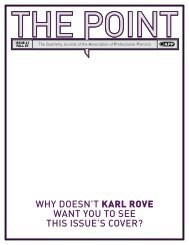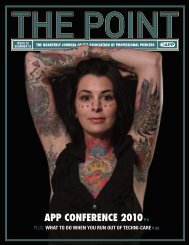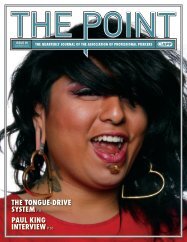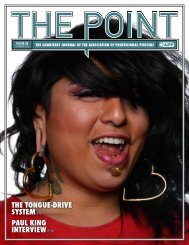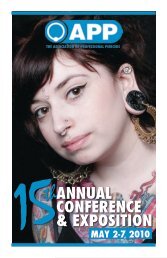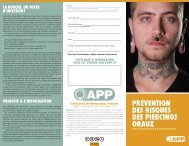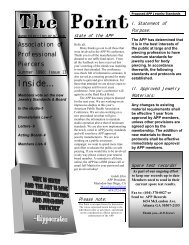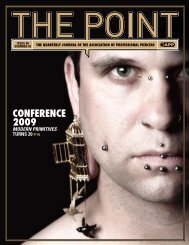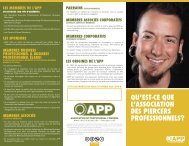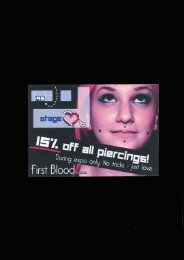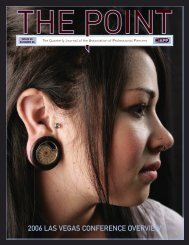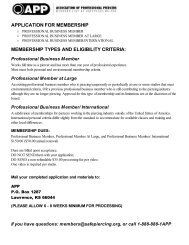Point Journal issue #56 - Association of Professional Piercers
Point Journal issue #56 - Association of Professional Piercers
Point Journal issue #56 - Association of Professional Piercers
You also want an ePaper? Increase the reach of your titles
YUMPU automatically turns print PDFs into web optimized ePapers that Google loves.
Pre-sterilized Needles and<br />
Piercing Instruments<br />
Elayne Angel<br />
APP President<br />
Yukatan, Mexico<br />
Earlier this year—while I was still the<br />
APP’s Medical Liaison—a Florida<br />
health inspector emailed me a<br />
question that deserves addressing<br />
here, in The <strong>Point</strong>. Her inquiry was regarding<br />
the APP’s stance on the prepackaged “sterile”<br />
instruments, needles, and jewelry that are<br />
being marketed and sold to our industry.<br />
(She had seen an increase in use <strong>of</strong> these<br />
items by piercers in her state.) When she set<br />
out to research the procedures used for the<br />
sterilization <strong>of</strong> these products, she reported<br />
that she could not locate any manufacturers<br />
<strong>of</strong> body piercing instruments, needles, or<br />
jewelry that follow the standards for sterility<br />
established in the United States for medical<br />
device manufacturers.<br />
In the U.S., manufacturers selling sterile<br />
products are obligated to follow the U.S.<br />
Food and Drug Administration 21 CFR<br />
part 820 and International Standardization<br />
Organization standard 13485 for sterilization<br />
to ensure that their products are safe and<br />
effective. These detailed good manufacturing<br />
practice (CGMP) requirements form a highly<br />
structured system for regulating quality,<br />
and govern the methods used in the design,<br />
manufacture, packaging, labeling, and storage<br />
<strong>of</strong> all finished devices intended for human use.<br />
All items used in a piercing (including<br />
jewelry, needles, tools, and any other<br />
supplies or equipment) must be sterilized in<br />
the studio using an autoclave that is sporetested<br />
regularly. The only exceptions to this<br />
would be medical supplies that come directly<br />
from a medical supply vendor who adheres to<br />
the requisite stringent standards, or a body art<br />
industry supplier who can certify that they<br />
uphold the same requirements.<br />
The APP Procedure Manual describes inhouse<br />
sterilization:<br />
“To minimize the risk <strong>of</strong> cross-contamination<br />
and to ensure that the piercing procedure<br />
eATING:<br />
is as clean as possible, many components<br />
<strong>of</strong> a piercing set-up are disposable.<br />
Unless supplies will be sterilized in a<br />
Statim autoclave immediately prior to<br />
the procedure, all disposables must be<br />
individually packaged in autoclave bags,<br />
sterilized, and remain in their pouches<br />
stored in enclosed, nonporous containers<br />
until use. Disposable materials that can<br />
and should be autoclaved include piercing<br />
needles, corks, rubber bands, cotton swabs,<br />
toothpicks, and gauze.”<br />
The excerpt below is from my book, The<br />
Piercing Bible: The Definitive Guide to Safe<br />
Body Piercing (Random House, May 2009):<br />
Even in studios where procedures are<br />
done only with disposable equipment,<br />
an autoclave must be used. A piercer<br />
cannot be certain that needles and body<br />
jewelry are sent in a sterile state or<br />
whether contamination occurs during<br />
shipping. Medical suppliers have stringent<br />
requirements for sterilization and<br />
packaging, but other industries are not held<br />
to the same standard.<br />
<strong>Piercers</strong> and body art business owners<br />
should pay close attention to this <strong>issue</strong> for<br />
the safety <strong>of</strong> their clients. It has become clear<br />
that many piercers are making the assumption<br />
that items touted as “sterile” are ready to use<br />
in the studio. However, this may not be the<br />
case when the products come from body<br />
art suppliers. While piercers aren’t medical<br />
pr<strong>of</strong>essionals, this is an area in which abiding<br />
by their practices is entirely appropriate.<br />
When you buy “sterile” prepackaged<br />
products from body jewelry and piercing<br />
supply companies, be aware that they are not<br />
bound by the same requirements that govern<br />
the medical field. For safety you must sterilize<br />
on-site all jewelry and needles, as well as<br />
forceps and other tools before use.<br />
• Slowly eat small bites <strong>of</strong> food that you put right onto your<br />
molars.<br />
• Don’t eat spicy, salty, acidic, or hot temperature foods or<br />
beverages for a few days.<br />
• Be extra careful <strong>of</strong> your jewelry when eating crunchy food.<br />
• Cold foods and drinks feel good and help reduce swelling.<br />
• Foods like mashed potatoes and oatmeal are hard to eat<br />
because they stick to your mouth and jewelry.<br />
• For tongue piercings; try to keep your tongue from twisting in<br />
your mouth when you eat because you can bite the jewelry<br />
when your tongue turns.<br />
• For lip piercings: be careful not to open your mouth too wide<br />
because your jewelry can catch on your teeth.<br />
• Each body is different and your healing time may be a lot<br />
longer or shorter than your friends’. If you have any questions,<br />
contact your piercer.<br />
WhAT TO AVOId<br />
• Do not play with your jewelry. You will cause permanent<br />
damage to teeth, gums, and other oral structures. See the<br />
APP Brochure: Oral Piercing Risks and Safety Measures for<br />
more information.<br />
• Avoid talking too much when your piercing is new. This could<br />
make ugly, uncomfortable scar t<strong>issue</strong> form, and make your<br />
healing take longer.<br />
• Avoid using mouthwash that has alcohol in it. The alcohol can<br />
irritate your piercing and delay healing.<br />
• Avoid kissing or contact with others’ bodily fluids like saliva<br />
while you are healing.<br />
• Avoid chewing on gum, fingernails, pencils, sunglasses,<br />
tobacco, and other foreign objects that could have bacteria<br />
on them.<br />
• Avoid sharing plates, cups, forks, and spoons.<br />
(“Hints and Tips” continued)<br />
TIPS FOR NAVel PIeRCINGS<br />
• Avoid stress and recreational drug use, including too much<br />
caffeine, nicotine, and alcohol.<br />
• Avoid aspirin as long as you are bleeding or swelling.<br />
• Avoid putting a healing piercing in a lake, pool, hot tub, etc.<br />
To protect a lip piercing use a waterpro<strong>of</strong> bandage (such as<br />
Clean Seals ). You can buy them in any drugstore.<br />
• Don’t smoke! It increases risks and lengthens healing time.<br />
• Wear a hard, vented eye patch (sold at pharmacies) under<br />
tight clothing (like nylon stockings) or use a piece <strong>of</strong> ace<br />
bandage around your body to keep it in place. Don’t use<br />
tape because it can cause a rash on your skin. This patch can<br />
protect your piercing from from being hit during sports or<br />
other dangers, and reduce irritation from tight clothes.<br />
• Wear clean, comfortable, breathable clothing that protects<br />
your piercing while you are sleeping.<br />
TIPS FOR eAR/eAR CARTIlAGe ANd FACIAl PIeRCINGS<br />
• Use the t-shirt trick: Dress your pillow in a large, clean t-shirt<br />
and turn it nightly; one clean t-shirt provides four clean<br />
surfaces for sleeping.<br />
• Keep everything super clean that comes near or touches the<br />
pierced area: telephones, headphones, eyeglasses, helmets,<br />
and hats.<br />
• Be careful when styling your hair, and let your stylist know if<br />
you are healing a piercing.<br />
Each body is different and your healing time may be a lot<br />
longer or shorter than your friends’.<br />
This brochure contains wording and information written specifi cally for minors. for additional<br />
information, please see our brochure Suggested Aftercare Guidelines for Oral Piercings.<br />
Disclaimer: These guidelines are based on a combination <strong>of</strong> vast pr<strong>of</strong>essional experience,<br />
common sense, research, and extensive clinical practice. This is not to be considered a substitute<br />
for medical advice from a doctor. If you think you have an infection, visit a doctor, but be aware<br />
that many doctors have not received specifi c training about piercing. Your local piercer may<br />
be able to suggest a piercing-friendly medical pr<strong>of</strong>essional. for more information, see the APP<br />
Brochure Troubleshooting For You And Your Healthcare Pr<strong>of</strong>essional.<br />
Use <strong>of</strong> this brochure does not imply membership in the APP. A current list <strong>of</strong> APP members can<br />
be found at safepiercing.org. false claims <strong>of</strong> membership should be reported to the APP.<br />
APP logo and name ©2011 <strong>Association</strong> <strong>of</strong> Pr<strong>of</strong>essional <strong>Piercers</strong><br />
Content and images licensed under the Creative Commons Attribution-noncommercial-no<br />
Derivative Works License. To view a copy <strong>of</strong> this license, visit http://creativecommons.org/<br />
licenses/by-nc-nd/3.0/<br />
2011 edITION<br />
Only when sterile items are purchased from<br />
medical suppliers—who must uphold strict<br />
CGMP standards—can articles be considered<br />
ready for use without sterilizing in-house.<br />
The only exception would be if your body art<br />
industry supplier can show you certification<br />
that they are following the same stringent<br />
standards required by the medical industry. P<br />
OUT NOW!<br />
Two New<br />
APP Brochures<br />
Aftercare for Minors<br />
and Oral Aftercare<br />
for Minors<br />
• Simplified language<br />
• Specifically for a<br />
younger readership<br />
• No mention <strong>of</strong> nipple<br />
or genital piercings<br />
This brochure contains wording and information written specifi cally for minors. for additional<br />
information, please see our brochure Suggested Aftercare Guidelines for Body Piercings.<br />
Disclaimer: These guidelines are based on a combination <strong>of</strong> vast pr<strong>of</strong>essional experience,<br />
common sense, research, and extensive clinical practice. This is no to be considered a substitute<br />
for medical advice from a doctor. If you think you have an infection, visit a doctor, but be aware<br />
that many doctors have not received specifi c training about piercing. Your local piercer may<br />
be able to suggest a piercing-friendly medical pr<strong>of</strong>essional. for more information, see the APP<br />
Brochure Troubleshooting For You And Your Healthcare Pr<strong>of</strong>essional.<br />
Use <strong>of</strong> this brochure does not imply membership in the APP. A current list <strong>of</strong> APP members can<br />
be found at safepiercing.org. false claims <strong>of</strong> membership should be reported to the APP.<br />
APP logo and name ©2011 <strong>Association</strong> <strong>of</strong> Pr<strong>of</strong>essional <strong>Piercers</strong><br />
Content and images licensed under the Creative Commons Attribution-noncommercial-no<br />
Derivative Works License. To view a copy <strong>of</strong> this license, visit http://creativecommons.org/<br />
licenses/by-nc-nd/3.0/<br />
2011 edITION<br />
TAkING CARe<br />
OF YOuR NeW<br />
ORAl PIeRCING<br />
TAkING CARe<br />
OF YOuR NeW<br />
PIeRCING<br />
18 THE POINT ISSUE 56



